Eigentlich braucht es viel mehr von dieser Art Datenbank – gerade im Gamedesign.
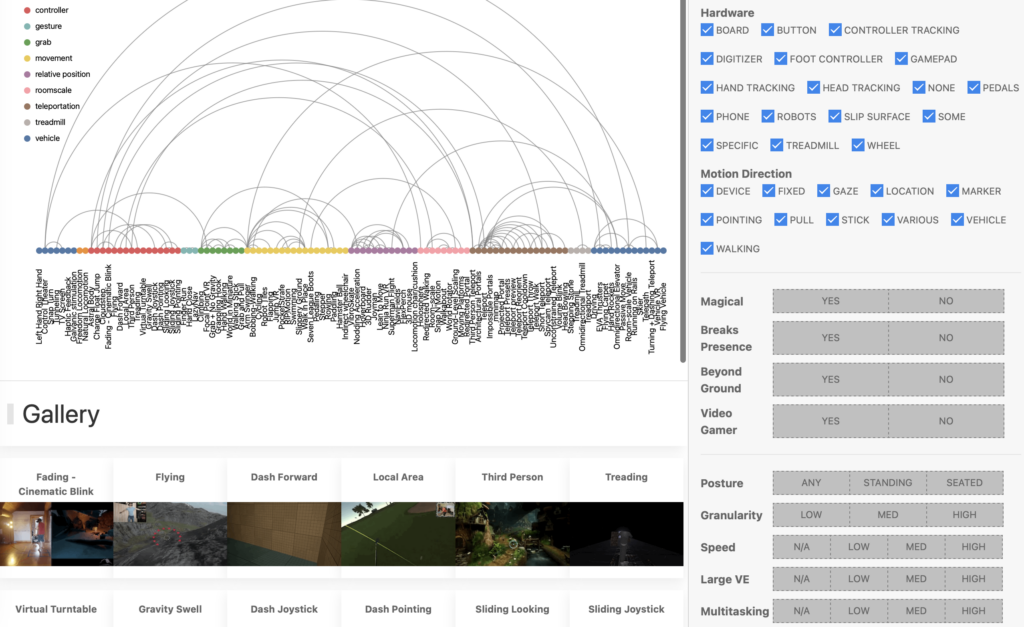
Eigentlich braucht es viel mehr von dieser Art Datenbank – gerade im Gamedesign.

Im Cartoonmuseum in Basel gibt es aktuell eine sehr sehenswerte Ausstellung zu R. McGuire. Seinen Arbeiten begegnet man* sonst in verschiedensten Kontexten, sei es im Kinderbuchbereich, Grafik-Ausstellungen, Multimediaausstellungen, bei Animationsfestivals wie dem Fantoche oder eben nun ‚zusammengefasst‘ im Cartoonmuseum > noch bis zum 3.11.2024.
McGuires Arbeiten sind in vielerlei Hinsicht (auch fürs Gamedesign – was wäre alles möglich!) interessant und inspirierend: Die Werke bearbeiten die verschiedensten medialen Überschneidungen wie Audio und Visuelles und gehen Fragen nach wie: „Wie lässt sich Auditives Visualisieren?“. Darüber hinaus geht es um die alte Frage des Minimalismus (im Grafikdesign) und in narrativen Mechaniken. Das kann sich um Formen und Narration handeln oder um Licht und Schatten.
Wie macht man aus einem Soundscape ein Bild? Die Comicscene hat da einige Lösungen gefunden und McGuires Bilder gehen diesen Weg weiter und lenken ihn noch mehr ins symbolische meist mit einfachen Formen.

Interessant sind dabei auch die fast schon Partitur-Ansätze zur auditiven Beschreibung einer Szene bzw. eines Soundscapes.
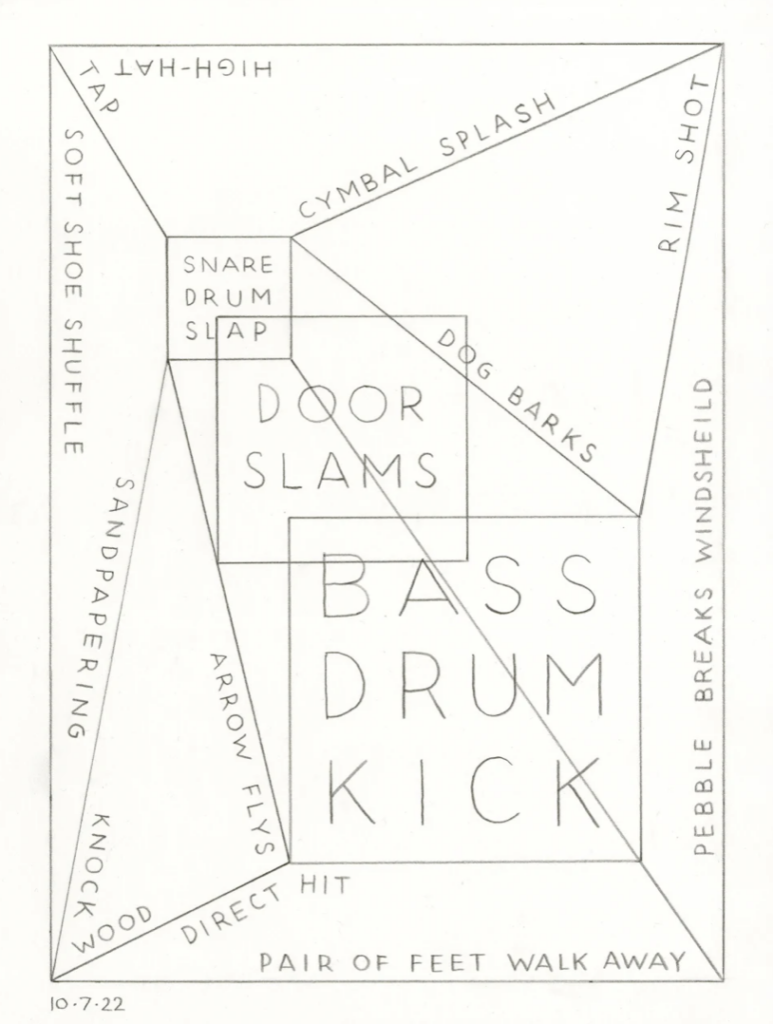
Im Film „Fears of dark“ (Verschiedene Animationsarbeiten verschiedener Autoren* zum Thema Fear) gibt es eine Kurzgeschichte, die atemberaubend mit Licht und Schatten spielt. Ein Mann im Schneesturm – offensichtlich auf der Suche nach einem Unterschlupf – kommt zu einem Haus und bricht ein. Das ganze wird mehrheitlich nur in Schwarz/Weiss ‚erzählt‘. Die Nutzung von Beleuchtung ist dabei sehr konsequent und radikal. Horror.
Wenn man sich vorstellt, wieviel gerade heute in ‚Generative Generierung von „Kunst“‚ in Verbindung mit Kryptowährungen gesteckt und verkauft wird und dies hier kriegt man einfach so während der Programmierarbeit auf dem Amiga, dann stellt man sich schon die eine oder andere Frage.
Eigentlich klar, aber dennoch erstaunlich: Moving Panaromas, die Vorgänger von Scrolling oder Parallax Effekten.
Mehr dazu findet sich hier auf Wikipedia >
Selbstverständlich funktioniert die Schriftrolle auch so, ist allerdings noch nicht mechanisiert/automatisiert.
Gefühle braucht es im Sport (um die geht es anscheinend nur im Sport – glaubt man dem unsäglichen Rufer von SRF und anderen Sportmoderatoren) – sind das wichtigste. Diese lassen sich auf jeden Fall ‚verkaufen‘ als Story in News.
Und so gibt es auf dem Amiga (neben dem legendären Speedball) ein Spiel, dass diese Gefühle der Spieler* und Moderatoren* defiktionalisiert. Es ist nicht mehr ‚Wie Krieg‘ bei Sportmoderatoren*, es ist Krieg.
Es braucht unsportliche Fouls an Stürmern, das muss sein (Sonst gäbe es ja Spiele mit vielen Toren – ein Graus). Aber jetzt geht es los. Bälle ohne Ende, Stürmer* ohne Ende.
Wer anfängt zu programmieren, simuliert zuerst immer das Programm selbst. Er führt das Programm aus, Befehl für Befehl, Zeile für Zeile. Ganz im Sinne der Turingmaschine – wir spielen unsere Rechensklaven. Wir spielen das, was wir externalisieren. Nicht tun wollen. Es ist ein Schreiben an eine Maschine, hinter der wiederum meist ein Mensch als Rezipient/User steht. Das laufende Programm bestätigt dann den menschlichen Interpreten und den User dabei (Erfolg) oder funktioniert gar nicht (Error) oder gar nicht wie gewollt (Error).
Wer als 13 Jähirger* (wie der Autor) sein erstes interaktives Programm „macht“. Der schreibt etwa ein Programm in BASIC auf einem Apple II in einem Computercamp. Und es geht um ein einfaches Programm ein QUIZ. Und so werden ganz einfach Prints, Inputs und Ifs verwendet, um einen QUIZ zu programmieren, zu Ländern und Hauptstätten.
10 PRINT "HAUPTSTADT OESTERREICH?"
20 INPUT A$
30 IF A$="WIEN" THEN PRINT "RICHTIG"
30 IF A$<>"WIEN" THEN PRINT "FALSCH!"Will man 10 Fragen, kopiert man den Code-Block mehrfach und füllt ein „England“, „London“ und so weiter.
Will man* 20 Fragen haben, dann kopiert man 20 Fragen und ändert ab. Selbstverständlich liesse sich das auch noch in Unterroutinen kopieren. Aber das Konzept bleibt dasselbe.
Eine fantastische Sache, eine Maschine, die das dann einfach so tut, Hundertfach kopiert und zeitunabhängig. AI der ersten Generation.
Wo sind die Grenzen? Das menschlich Zumutbare? Was wenn etwas unendlich oft gemacht werden soll, etwas was menschlich völlig unklar ist und weit über den Einzelnen hinausgeht. Dafür haben Menschen früher andere Menschen ausgebildet, beeinflusst per Bücher, Schulen gegründet etc. Aber hier?
Dann kommt (konkret lernt man) den Befehl GOTO. Dieser lässt das Programm oder den Ausführer irgendwohin springen und da weitermachen. Und ja da erschafft man die Unendlichkeit, den Loop, der niemals mehr aufhört. Damit überschreibt das Computerprogramm das Menschliche, das Zeitliche und wird theoretisch ewig. Es ist kein Programm mehr, das auf Menschen läuft. Es ist entkoppelt, eine Extension, die einfach ohne uns läuft. Es ist letztlich die Macht der eigenen Extension, des kleinen eigenen Simulation, der uns überdauerenden Simulation und die Ewigkeit, die uns gleichzeitig zeigt, dass wir nicht mehr sind und doch etwas von „uns“ weiterprozessiert.
Es ist kein Wunder geben viele irgendwo (als Überbleibsel) mal ein Derivat von folgendem Code ein und schleichen sich dann davon.
10 PRINT "EWIGKEIT";
20 GOTO 10JMP, GOTO oder dann auch LOOPS überspringen uns als Menschen und sind letztlich zutiefst unmenschlich.
WeiterlesenMehr gibt es nicht zu sagen. Natürlich noch viel, aber die Musik/der Video ist schon recht treffend für Hollywood und dahinter Games.
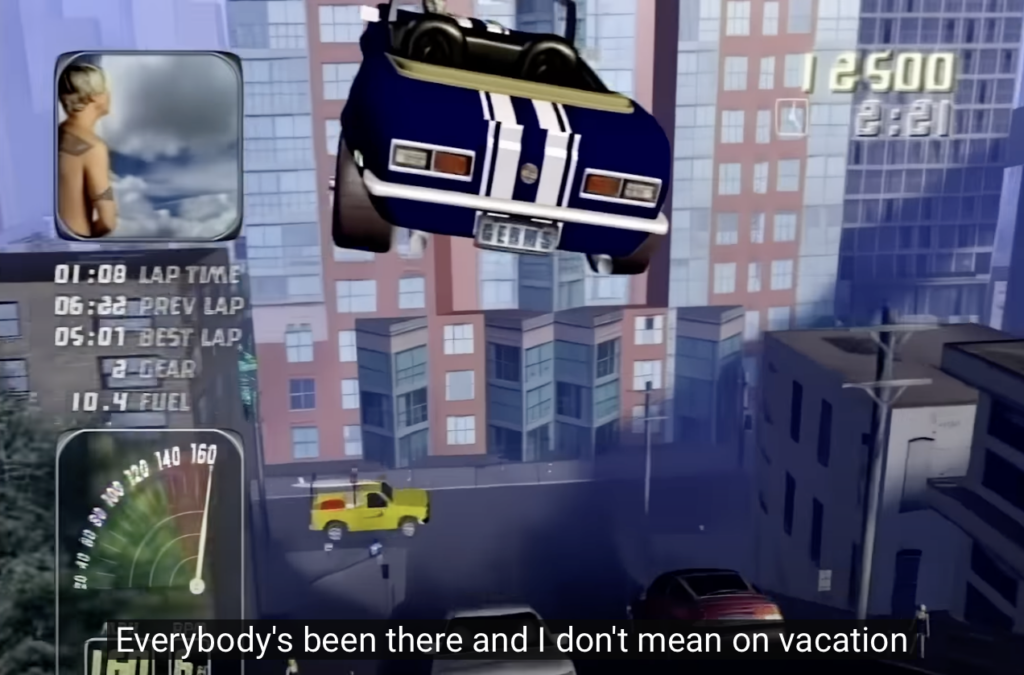
Part 4: The Publishing Business
LINEL was a software developer and game publisher based in Switzerland. The label was active from 1987 to 1995.
Part 4 will focus on the publishing business with the physical production of the commercial games, distribution and marketing strategies and communication efforts by LINEL.
The real beginning of LINEL
In conversation, Markus Grimmer explains that he actually came from an electrical background and had nothing to do with computers. His company sold lighting. “I was looking for an accounting program and saw that it was written by a developer from St. Gallen and asked him if we [LINEL] could distribute it. He finished programming it but gave it to someone else to distribute. I met the programmer in a C64 shop in St. Gallen and then came across the games. Whenever you went to the store in St. Gallen, they had pirated discs behind the counter that they could bring out on demand. And I said to myself that these discs might also be [legally] imported into Switzerland and [officially] distributed.” Grimmer then wanted to start selling software but realized that a lot of things were being hacked in Switzerland. “I got to know the hacker scene and the programmers. (Grimmer in conversation with Suter 2023) First of all, these were Chris Haller and Christian Weber. Grimmer held the two programming cracks in high regard. Grimmer had also signed an employment contract with Chris Haller, but this soon led to conflicts. And Christian Weber had worked independently on games such as Dugger 2 and Dragon Slayer, but they did not get completed.
In the medium term, LINEL was determined to make a name for itself as a development label. Main reason for Grimmer was that publishing games in Switzerland alone was a very difficult financial undertaking. “There were no investors in Switzerland who were willing to take on this level of risk in a branch that was not known to them. When we made The Neverending Story II, I was very lucky that the company Merimpex from Lichtenstein wanted to invest. They had previously invested in a smaller game, and they got back much more than they had anticipated.” (Grimmer in conversation with Suter 2024d)
Publishing and Distribution
There were no other investors to be found. There were no financial prepayments by the distributors or guaranteed purchase for the publisher. Grimmer says that Dragon Slayer was the first product where Ubisoft told him that they would guarantee 15’000 copies each for Amiga and Atari ST. “We never had such guarantees before. The graphics were really a sensation at the time. Even Ubisoft was amazed. But when I wanted to have it in writing and said, ‘send us some money so that the game can be finished quickly’, the interest dropped again.” (Suter 2024d) There was a kind of digital gold rush. “If you could move two pixels across the screen, you felt like you had made the next top ten game. And there were a lot of frantic programmers who promised things and never delivered. Unfortunately, a lot of publishers got screwed and lost a lot of money, as did the distributors.” (ibid.)
According to Grimmer, LINEL spent between £30,000 and £40,000 on legal fees for license and copyright violations. He says: “At some point I stopped. It was not doing much good. Although certain things should not have happened. For example, scenes from Dragon Slayer (fig.1) appeared in Rings of Medusa ROM Gold (1994), which was a clear copyright violation. But I stopped [the lawsuit] because everyone involved could only lose. And we also knew that Dragon Slayer would not be released anymore. I did not want to put any more obstacles in the way, but it was never clarified whether assets from that game could be used or not. They just did it.” (ibid.) The problem was that there was no legal basis at the time. “We had a big trial before the copyright court in Frankfurt. The judge was simply overwhelmed. He was not familiar with the legal subject ‘game software’. He said he had to decide from his gut what was right and what was wrong.” (ibid.)
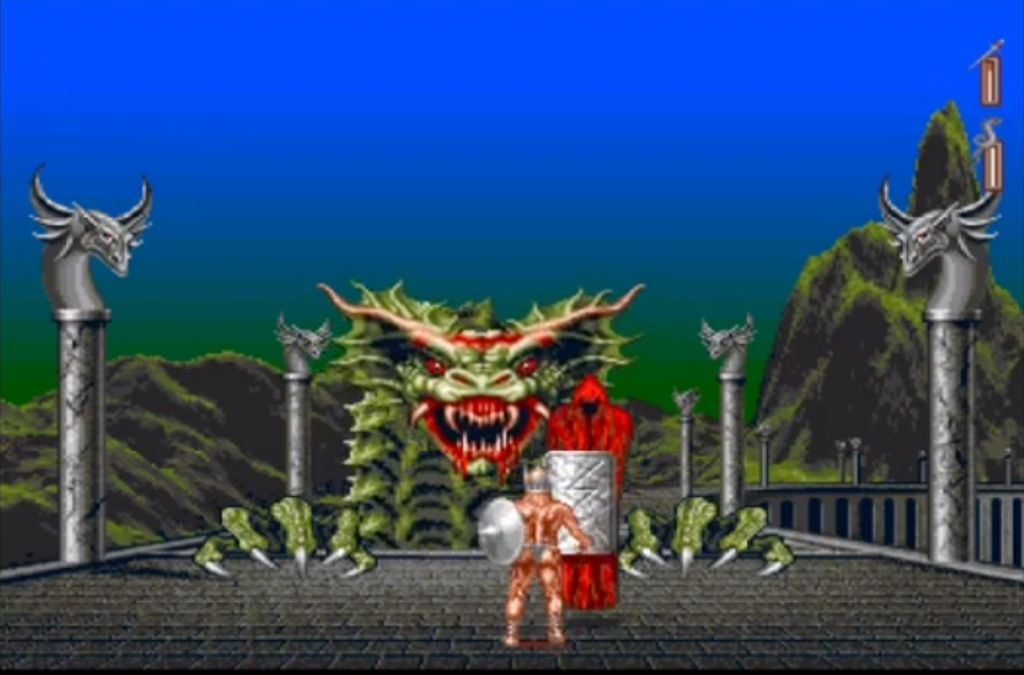
Figure 1: Scene from the unreleased game Dragonslayer (1989) Source: CDTV demo version
The physical production of the games
The entire production of the games for LINEL took place in England. Grimmer used John Allen’s duplication factory[1] in High Wycombe, northwest of London. The name is only mentioned in the imprint of Necronom (1991): ‘Copytec, England’. John Allen was already in his fifties and had a lot of experience with duplicating tapes, cartridges and disks, especially for the Sinclair machines and the C64. He did all the duplications for LINEL. He also organized the boxes and the printing of the covers and manuals. LINEL started with the big boxes. Insanity Fight (1987) came in a relatively large and flat box. Later, LINEL switched to the ‘Euro box’, a smaller but relatively thick cardboard box.
“Many games did not really need a manual”, says Grimmer. “But we still made instruction booklets so that the box would rattle. If you picked up a box, it had to rattle. Because if they had to spend £ 24 for a case and it weighed nothing and there was nothing in it, that was psychologically bad.” (ibid.) It needed to clatter as much as possible. “For The Champ (1989), we also put key rings in the box, so that it would bang as hard as possible. We produced thick manuals, if possible multilingual, so that the number of pages could be higher and the printing price cheaper.” (ibid.) The box was quite heavy when you picked it up.
“Boxing the Kaiser game was astounding. We put out Kaiser (1989) for Amiga in a big plastic box that had intaglio print and looked like a big, sophisticated book when you opened it. But in order to place it in England, we had to ‘break the arms’ of the retailers. They said we could forget about it, they would never put it in the stores, because they wanted to put as many games as possible in one display, and all the products there were standard size except ours. But when they saw that the game was relatively successful, they started displaying it.” (ibid.) The deluxe version of Kaiser (fig.2) came with a boardgame that could be played parallel to the computer game. The board was a medieval map of Germany that came in six sections. The board looked rather impressive, but the tokens with which the players were supposed to track their progress were out of paper and rather small. The map shows the middle of Europe around the year 1700 with seven states like Tyrolia-Austria, Bohemia and Bavaria that made up the bulk of the Holy Roman Empire. The game itself came on two disks with the tag “Amiga conversion by LINEL 1989”. The booklet however was a 1987 version of the manual for the original Atari ST version by CCD Dirk Beyelstein. Underneath the booklet, there was a leaflet with some important remarks for the Amiga version. The PC-version that was also converted by LINEL came out in 1992. The big box of Kaiser (1989) is not to be confused with the later Kaiser Deluxe (1995) version for PC on CD-ROM that was distributed by Softgold. The big box sold relatively few copies in England. It sold a little better in Germany. In the USA the game was only released in a normal cardboard box.
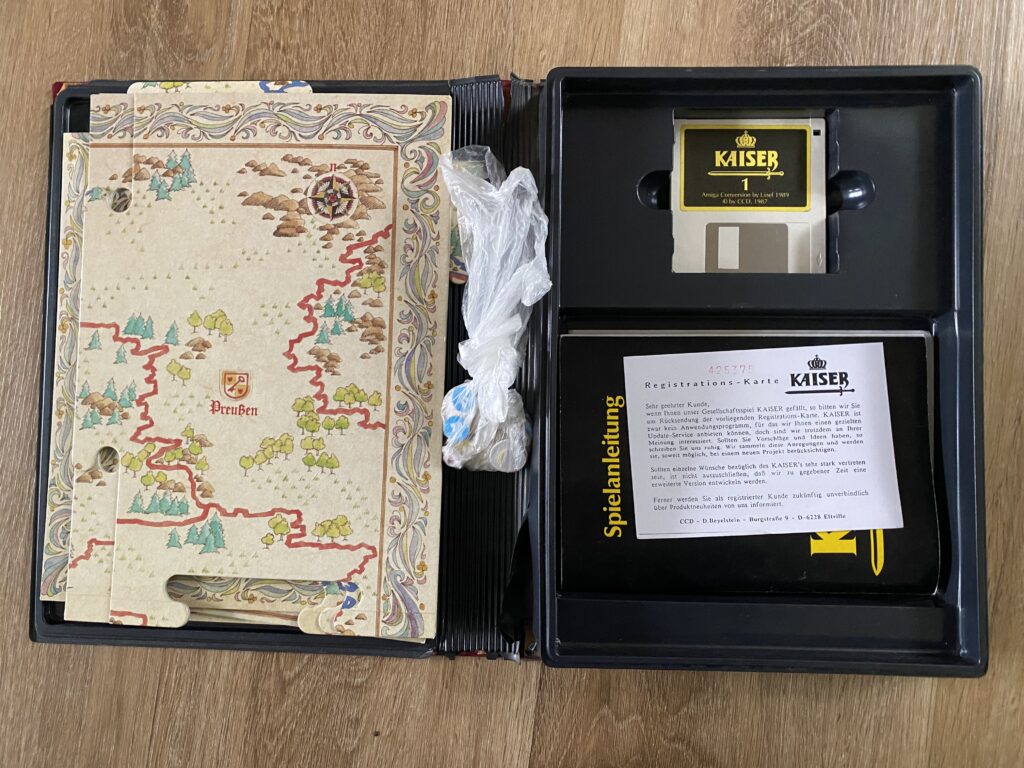
Figure 2: The mother of all boxes – Kaiser (1989) – comes as a sophisticated oversized book, measures 35 x 27 x 5 cm and contains the videogame and a boardgame to track the game state. Source: Suter
John Allen from Copytec not only organized the boxes for LINEL, but also made the packaging and shrink wrapped them with a plastic foil and made them ready for the stores. Even the German versions of the games were mostly produced in England and then shipped directly from England to Germany, Austria, and Switzerland. The other countries did their own production through distributors. “Once or twice, we did some production in Austria, in Vorarlberg at a large printing company. This printing company was the only one that printed directly on the box. Anything from England was laminated. It was a cardboard box, on which they stuck the print as paper.” (ibid.)
At that time, all Euro boxes were laminated. Later, the company switched to producing directly printed boxes. From then on, LINEL ordered the boxes from various manufacturers in Germany. The Italian versions and packaging were produced in cooperation with GENIAS. GENIAS had a duplication plant in Bologna and cooperated with Sofitel. There, LINEL’s items for Italy were duplicated. These were games on cassettes and duplications of 3 ½ and 5 ¼ inch disks. Later, for the CD-ROMs, other specialized duplication facilities were used. But according to Grimmer, LINEL never released a game on CD itself. The later LINEL games on CD-ROM were licensed from other publishers such as Softgold, Software 2000, Gong Verlag and Computec Verlag.
Many of the manuals were written by Markus Grimmer in cooperation with the coders and graphic artists. Claudio Ambrosi, who had been with LINEL since the beginning and had worked on graphics and music, also wrote many texts. (fig.3) According to Grimmer, Ambrosi wrote many press releases, manuals and translated them into Italian. LINEL also did some of the game translations itself. This stopped when Grimmer started selling just licenses. “When we sold licenses, the publishers had to send us the translations and we implemented them.” (ibid.)
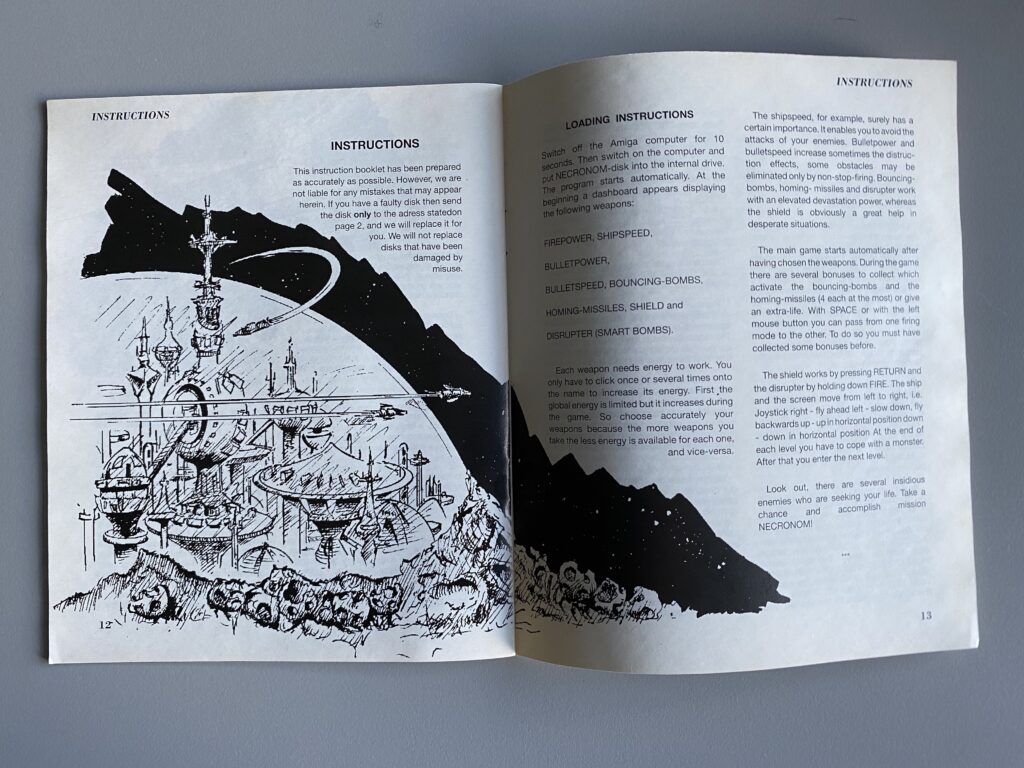
Figure 3: Example of a booklet that was written by Grimmer and Ambrosi – Necronom (1990). Source: Suter
Marketing
It was often marketing aspects that decided the price of a game. At the time, a game cost around £19. “We had to pay two to three pounds for the box, a disk cost one pound to 1.50 pounds, depending on the number of copies. So, three disks for a text adventure did not pay off. You could no longer sell the game for £14 – 19 but had to raise the price to £24 – and no one wanted to pay that,” remembers Grimmer. There were also very few games that came out on two disks. That was a cost issue. You had to pay between 50 and 65% to a retailer. For lesser-known games, it could be as much as 70-80% with full return rights. “If you produced 10,000 copies and only sold 2,000, the distributor was left with 8,000 games that could have been pulped. Eventually, you received the money from the sales, but it came with a bill for what was not sold. That could have been e a big blow for your business.” (ibid.)
Times were changing quickly. In the early 1980s, you could put out whatever you wanted. Anything could be sold. And many distributors were willing to take a risk. “But just at the time when we started, things changed dramatically. If you produced two or three flops, you were out of business very quickly.” (ibid.) The game publisher was then the one that had to bear the risk. “This was a reason why we sold more and more licenses and produced less and less ourselves. It was getting very expensive to produce the games ourselves.” (ibid.)
Licensing
LINEL had also purchased licenses for game development, including in Taiwan, from Dynasty International Information Co., a game developer in Kaohsiung City. LINEL had negotiated a counter-deal with the Taiwanese developers. Asian countries had long been considered pirate countries. “Many Asians came to the London [Entertainment Computer Show] show and made sure they got demo versions of the games. They then copied the games 1:1 at home, especially in China” (ibid.) in the original look and with the same objects in the packaging. This looked exactly like what was done in Europe. “Only they didn’t pay any licenses for it. This Taiwanese company came to us and wanted to buy licenses. They then officially released at least two of our products, including The Neverending Story.” (ibid.) But despite its first intentions, LINEL itself did not make use of the licenses it had acquired. The three licensed Taiwanese games were never released in Europe because after close inspection Grimmer concluded that there was no market for that kind of game in Europe. The game Battle Commander was announced in the booklet of Game of Life (1992), but LINEL handed the license over to Merit Software for the American market. Grimmer says: “The Americans liked this type of game, and we passed Battle Commander on to Merit Software for publication. However, I only arranged this and had no further involvement.” (Suter 2024e)
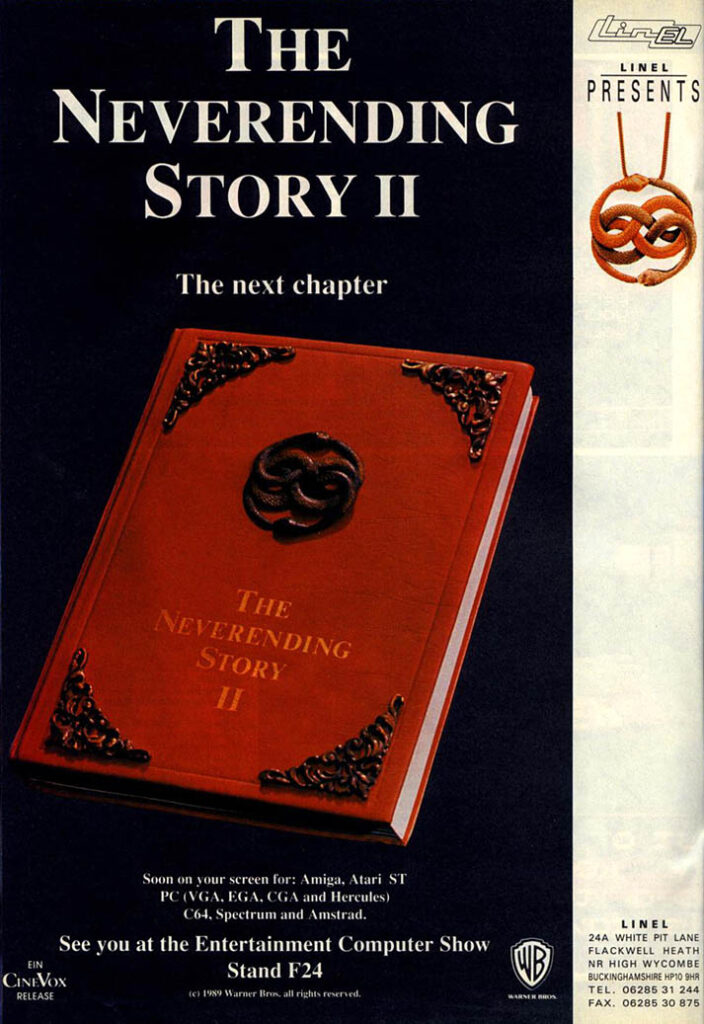
Figure 4: Advertisement for The Neverending Story (1990) with LINEL address in UK. Source: Lemonamiga
In 1990, LINEL acquired the licenses for The Neverending Story for Europe and Asia. (fig.4) And Merit Studios purchased the license for America. “For Europe, the license was extremely expensive at the time. In America, people didn’t know the movie that well, so the license was relatively cheap. Merit Studios got it for $30,000”, says Grimmer. The Americans distributed LINEL’s game on the C64, Atari ST, Amiga and PC platforms. In Europe, LINEL added CPC-Schneider and ZX-Spectrum versions. This meant that all six computer platforms available at the time could be targeted for game sales. Grimmer says: “This was the only game we made for all platforms.” (Suter 2024d) But that was just the beginning. In addition to the arcade game, LINEL wanted to make an adventure game with same movie plot. “We had a good relationship with Peter Geissler, the producer. He told us to start right away and wanted to provide us with material.” (ibid.)
In the end, it failed because of the license agreements. At the time, Warner Brothers had a contract with Entertainment Munich to sell the licenses for the film. Grimmer: “The company really inflated itself, was listed on the stock exchange and then disappeared from one day to the next. They wanted to extract extremely high license fees.” LINEL paid around 100,000 Swiss francs for the arcade game license. “So that was an expensive business. And they wanted even more for the adventure game.” (ibid.) At the time, the movie was the first film to cost over 50 million. But LINEL had already bought an expensive license and didn’t want to buy a second one or at least they wanted to cut a good deal. The negotiations failed, however, because Entertainment Munich insisted on “extremely high fees”, Grimmer remembers. “We had a good relationship with [author] Michael Ende, who was very computer-savvy. He was very critical of the movie himself, but he really wanted a computer game, and he had some interesting ideas for the prospective adventure game. The game itself should have been kind of a character and was supposed to develop like an artificial intelligence.” (ibid.)
When asked if LINEL was able to recoup the 100,000 Swiss francs for the license, Grimmer laughed and replied: “I would say we came out with a red zero. It wasn’t the success we were hoping for. That’s why we never bought another big movie license.” (ibid.) Nevertheless, LINEL continued to work on smaller licenses, particularly comic book licenses. “And then we came across Karl May Verlag in Bamberg. But they already had a contract with the game company Rushware.” (ibid.) Softgold’s managing director, Marc Ulrich, had bought the book rights for Rushware rather cheaply, but had never done anything with them. The Karl May Verlag was very disappointed. Two or three years earlier there had been an announcement for a Karl May game, most likely Old Shatterhand (the best-known Karl May book), but it never came out.
The Karl May Adventures
Grimmer: “The publisher told us at the time that Der Schatz im Silbersee (The Treasure of Silver Lake) was the most successful book that had not been licensed. They then offered it to us. The contract was made on short notice at the book fair, and one year later we could already present our game “Der Schatz im Silbersee”. The Karl May Verlag secured a right of co-determination on the script and the presentation and was advising LINEL during the entire development and “took care of an optimal and faithful adaptation” (Quote from the booklet for the game Der Schatz im Silbersee: Grimmer (1993), p.5). The booklet contains a prequel to the story of Old Firehand and Winnetou on 22 pages. A faithful start for the game adventure that leads the player like the reader of the book from Arkansas to the Rocky Mountains. For the release, LINEL also brought in the German publisher Software 2000, who then took over the distribution of this product. The game (for PC) was quite successful in Germany. (fig.5) After that, LINEL tried to produce an Amiga version and planned an English version as well as a second game with the Karl May title Durch die Wüste (Through the Desert). LINEL’s Karl May game adventures were about to become a series. In the booklet it says on page 5: “[…] it will be the start of a number of games. The next adventure is already in the works and should give everyone the opportunity to experience the many adventures Karl May left us and which we know from his books.” (ibid.)
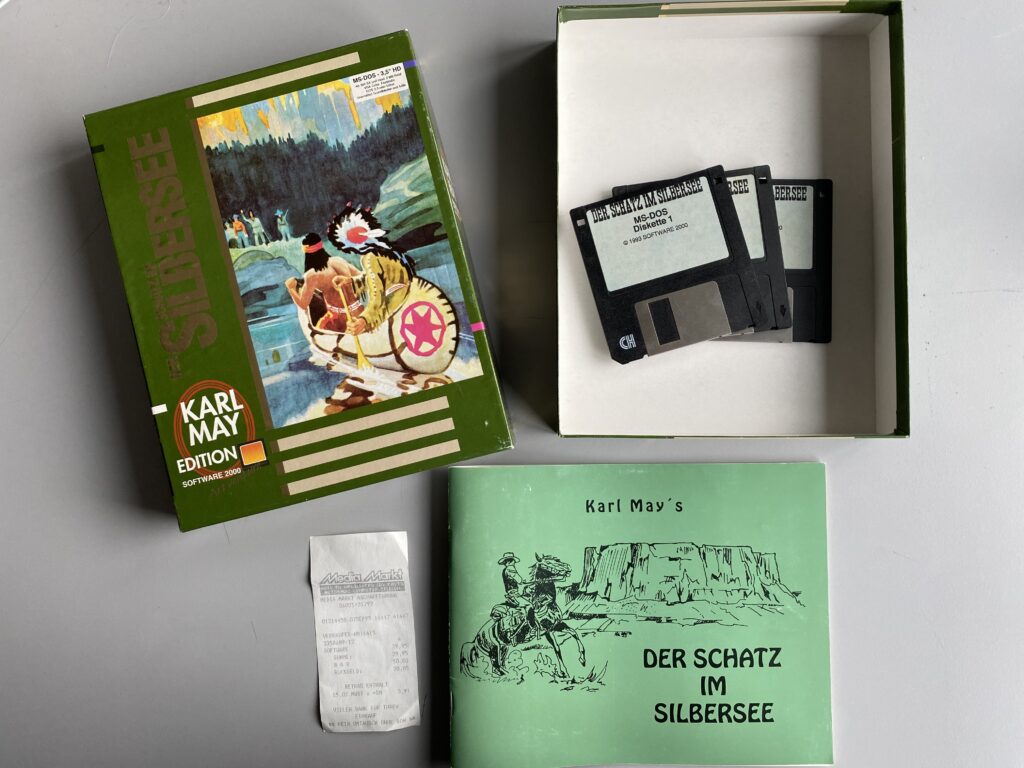
Figure 5: Der Schatz im Silbersee (1993), Box with disks, booklet and sale’s receipt. Source: Suter
Programmer Arndt Hasch had previously developed an adventure game engine for LINEL that was to compete with Lucas Arts’ SCUMM engine and was to be used for the unfinished adventure game The Neverending Story II. He called it MACS (Modular Adventure Control System). The magazine Amiga Games 8/1993 pointed out that the entire MACS had to be rewritten for this purpose, although it was already completely finished. Hasch was a PC programmer, therefore the adventure was first released on PC in 1993. Unfortunately, it didn’t go any further. “Then we had a financial bottleneck,” Grimmer explains. “Software 2000 had not made the agreed-upon advance payments. They were running out of money themselves. And we had no money to pay the programmers now.” (Suter 2024d) As a result, the Amiga version was not finished and the next adventure Durch die Wüste that was planned for 1994could not be developed any further. (fig.7) “Arndt Hasch himself left us; he got an offer from a German competitor. And I never heard from him again”, says Grimmer. “We were allowed to continue using MACS and hired another programmer. I personally invested a lot of money in it, but after about 6 months we had to dissolve the project because the programmer didn’t get far enough, and Software 2000 didn’t keep its promises.” (ibid.)
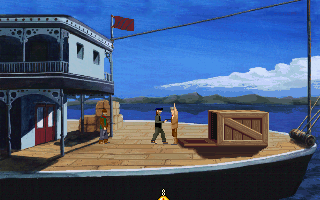
Figure 6: Screen from Der Schatz im Silbersee (1993). Source: Demo Version LINEL
Der Schatz im Silbersee (1993) was only released in German, not in English. The reason for this, according to Grimmer, was the rapid development of visual techniques that year. “The first version of our art was good enough to sell. (fig.6) But the graphics had developed so quickly that the same graphics would not have been sufficient for an English version a year later.” All the artworks would have had to be redone. In addition, the content of Durch die Wüste needed to be more neutral and better suited for the British market. In Grimmer’s opinion, Der Schatz im Silbersee had the mentality and structure of a German western and was therefore not necessarily suited for the British market. But in general, “we had a very good artist on board for the animation of the planned series, and that was Carl Bihlmeier”, a comic-strip artist made famous by computer magazines. “His mixture of comic and realism was very well received. And of course, we had the hope to be able to break through internationally with the MACS system.” (ibid.)
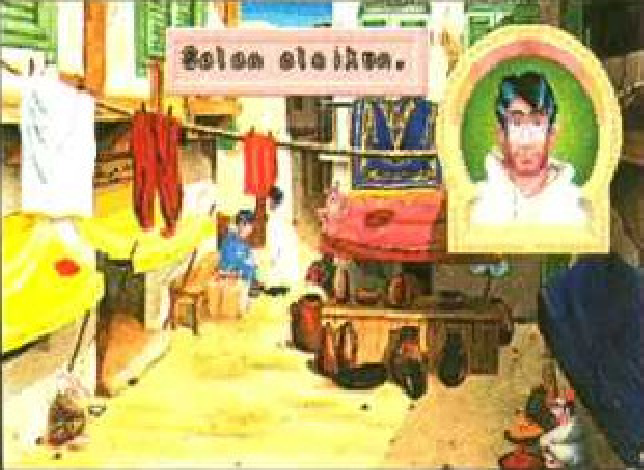
Figure 7: Screen from the demo version of the unreleased game Durch die Wüste (1994). Source: Demo Version LINEL
Second publications in Disk Mags
After the Karl May adventure game series was discontinued, LINEL stopped publishing its own games. On the one hand, Grimmer’s company concentrated on fulfilling existing contracts until they expired. On the other hand, Grimmer negotiated with Gong Verlag and organized secondary releases of some of LINEL’s games in so-called disk mags. These releases started in 1990 with the game World Cup 90 (1990) by GENIAS in the Golden Disk 64 series (fig. 8), as well as in Computec’s Amigo! series, for which you could even get a 4-player module (Amiga version) and continued until 1996 with the two presumably last releases in disk mags of Traders and Kaiser Deluxe (fig. 9) by Bestseller Games.
Gong Verlag was owned by Swiss entrepreneur Jürg Marquard, who was responsible for the publisher’s magazines. And Adolf Silbermann was responsible for the flagship of the time, the TV magazine Gong. Together they were the managing directors of Gong Verlag. Gong Verlag was later merged with Computec Verlag. And Marquard left and joined Focus, a new product of the Burda publishing company, for a while. Today the company is called Computec Media AG and is a subsidiary of the Swiss Marquard Media Group. At the time, Silbermann became the sole managing director but remained in the background. Grimmer explains: “His partner had a son, Christian Geltenpoth, who had founded Computec Verlag in 1989. He had the idea of copying some floppy disks, sticking them on a cardboard print and taking them to the kiosks as a magazine.” (ibid.)
This was a successful move because Germany had a law, the Postwar Press Law, which ensured that freedom of the press and diversity would continue to exist. This meant that if a newspaper was produced, it had to be available on newsstands. Grimmer continues: “Geltenpoth started with a C64 disk. It was a disaster because he didn’t know the software market. But he sold thousands of copies anyway.” (ibid.) Probably because fathers felt guilty when they went to the kiosk to buy cigarettes and a newspaper for themselves and bought another disk for the kids to play with at the weekend. In the beginning, it was just junk. “I met him at a fair and he said he wanted a professional game for his series, would it be possible to get a license?” Grimmer: “I asked him what was in it financially?” (ibid.) In England at that time, disks were also glued to magazines. But no separate issues or boxes were made for them. And a publisher received a maximum of £2000 if one of their games was distributed through a magazine. Grimmer continues: “As a bluff, I told him he should expect to pay 20,000 DM. He immediately asked how many games [disks] I could deliver. And we were in business. For him, 20,000 DM was peanuts.” (ibid.)
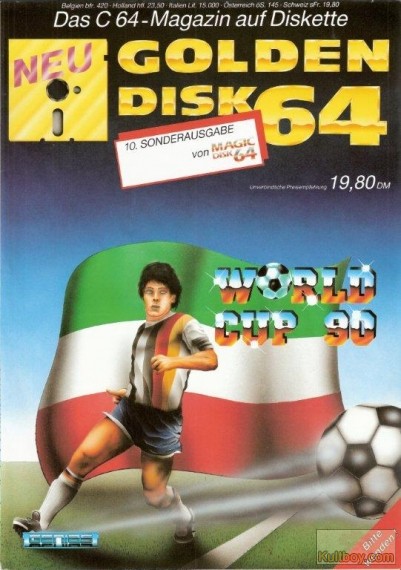
Figure 8: Disk Mag Golden Disk 64 with World Cup 90 (1990). Source: Kultboy
The first game Grimmer published with Geltenpoth was World Cup 90 (1990) by the Italian cooperation partner GENIAS (fig. 8). A total of 150,000 copies of the simple soccer game were sold for the 1990 football World Cup, which took place in Italy. Grimmer explains: “Only, we didn’t launch the game eight weeks before the World Cup as planned, but during the World Cup!” (ibid.) Sales of the game did not begin until two weeks after the start of the World Cup. The potential could have been even greater.” Grimmer goes on to talk about the different versions and their qualities: “The C64 version was the most successful. The Amiga version was the only one you could really play well. The C64 and PC versions were rubbish. The PC game was a disaster. All you had was one giant pixel for a head and two pixels that moved back and forth as legs, and a ball that was bigger than the head.” (ibid.) The Italian partners were very excited about the sale. They had probably never imagined that their games would sell so well. “That gave us the idea of re-releasing games that had already been sold in the form of disk magazines.” (ibid.) Over the next six years, LINEL re-released between 10 and 15 games in disk magazine form. Some of the games had to be reworked or even ported, like Traders, which was not only re-released as an Amiga version (Bestseller Games Special 5), but also as a PC version (Bestseller Games Special 13) (fig.9). However, in many cases Grimmer simply negotiated licenses for re-releasing existing games.
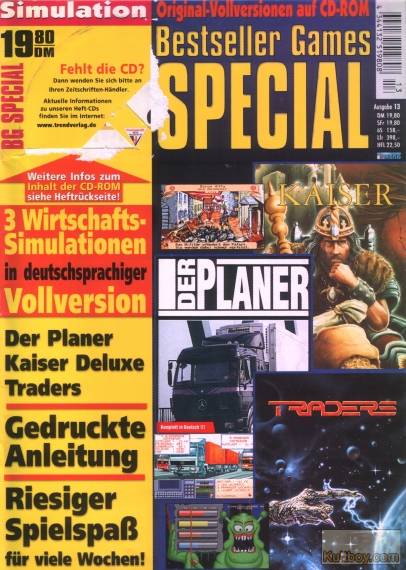
Figure 9: Kaiser and Traders for PC (1996) on a disk mag edition for Bestseller Games Special 13. Source: Kultboy
Christian Geltenpoth also wanted to publish the whole thing in England. “Together with him, we set up a publishing company in England and produced all the content in Switzerland. Claudio Ambrosi was very much involved.” (ibid.) But then there were organizational and aesthetic differences. “Geltenpoth had a designer friend do all the covers. But the covers looked a bit childish. Our covers, on the other hand, looked completely different.” (ibid.) As an example Grimmer refers to the box and cover art for Necronom (1990) (fig.10), which, like other LINEL covers, was done by Englishman Steve ‘The Brush’ Smyth[2]. “We also had other graphic artists who did high quality covers. I said we should use professional covers by artists like Smyth. He ended up kicking me out.” (ibid.) However, a severance package was agreed, so Grimmer was no longer part of the company, but still had to deliver some games. The Gong Verlag held 50% of the German series and Geltenpoth’s Computec Verlag also held 50%. The magazines Amiga Games, PC Games and Playtime were also part of it. The whole thing was later floated on the stock market. Swiss entrepreneur Jürg Marquard then bought shares again and soon took over Computec Media completely (see part 3, footnote 4).
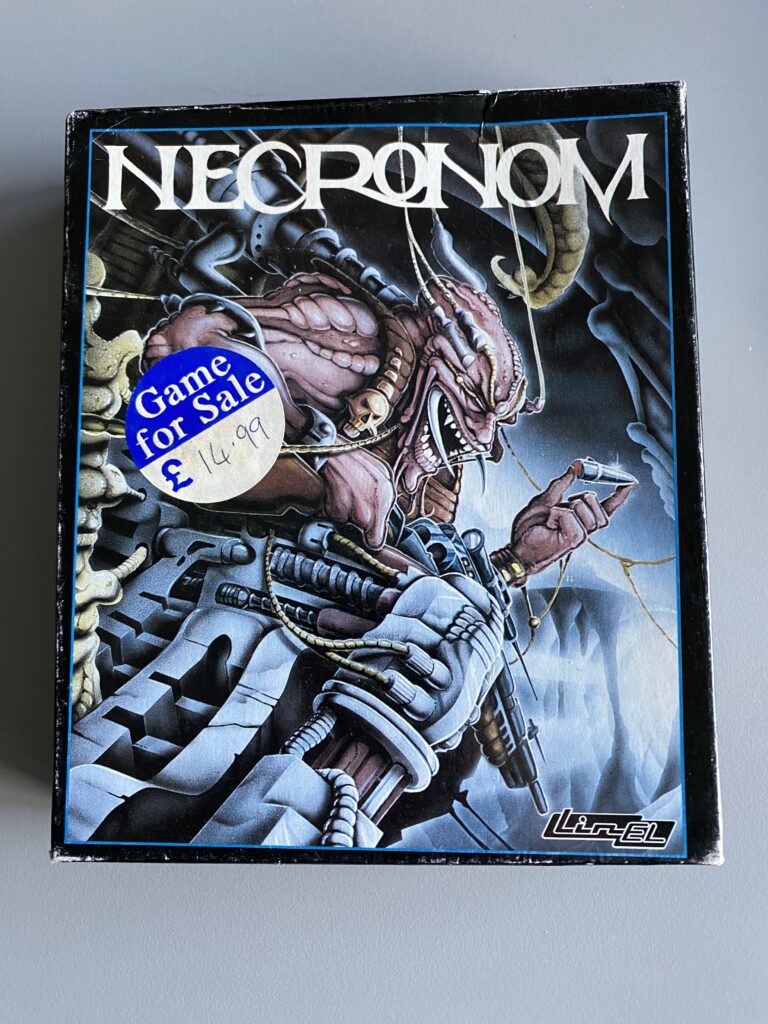
Figure 10: Cover Art von John ‘the Brush’ Symyth for LINEL’s Necronom (1990) Source: Suter
John Allen’s duplication factory in High Wycombe, called Copytec (see footnote 2), was also the disk supplier for LINEL. The site is now a nail salon. “Behind it, in the brown building, was the duplication plant with the machines,” Grimmer recalls. “The incoming disks and boxes etc. were stored in front. We used this address after we stopped cooperating with Sales Curve. Everything that was duplicated for us was done there. John Allen was an entrepreneur with a lot of experience in the industry. “He continued to run the office there for Christian Geltenpoth after I left. Geltenpoth sent people from Germany. And I also organized two journalists from England for them.” (ibid.) The magazine was published for six months, but failed because the concept did not take off the same way it did in Germany. In England, the pressure to have the magazines displayed on newsstands was not as great. “And Geltenpoth’s magazine had little quality in content, and the games that were stuck to the front cover were no better than what others had. These magazines with the disks on the front also had to be very cheap, around £1.90. “It was ridiculous. In Germany a Disk Mag sold for 14 or 19 DM. In England, the quantities and margins weren’t right, so they soon stopped their UK disk magazine project. LINEL itself had no games in Geltenpoth’s English magazine or other English game magazines.” Grimmer points out: “We only published full versions of our games in the UK.” (ibid.)
Other countries
LINEL sold licenses for its own games before the Disk Mag era. The goal was always to establish distribution in other countries. In some cases, guarantee sums were obtained, which then could be reinvested in the production process. Some games were released in multiple languages. The game The Champ (1989) even had a multilingual booklet. The game itself had no language, so LINEL was able to design a booklet with manuals for all languages and use the same packaging for all countries. This was a good move. In France, the games were distributed by the publisher Génération 4 with the video game magazine of the same name, Gen4 (1987-2004). LINEL also collaborated with Titus Software. Hervé Caen and his brother took over Herbie Stone and published Crack (1988). “But France was very difficult territory,” recalls Grimmer. “If you didn’t work with a French distributor, it was almost impossible to sell games there. And you always had to provide French instructions.” (ibid.)
As a software company, Ubisoft also had its own sales department. At that time, it was still named after the founders, the Guillemot brothers. Guillemot distributed some LINEL products in France, “but by no means all of them. Guillemot was very selective. The French were quite complicated. They had a legal requirement that all games released in France had to have French language and manuals. Even an arcade game without a language had to have a French manual. A lot of people would just put stickers on it to show that it was French.” (ibid.) The major distributors in France were so selective that others, such as Softgold, could not avoid opening an office in the country. “Infogrames was a little bigger than Ubisoft at the time. But then Ubisoft took over a lot and grew. Infogrames was also working with Rushware. […] We never really got a foothold in France.” (ibid.) The Neverending Story II (1991) (fig.11) was distributed in France by Guillemot, “but the game was not very successful there.” (ibid.)
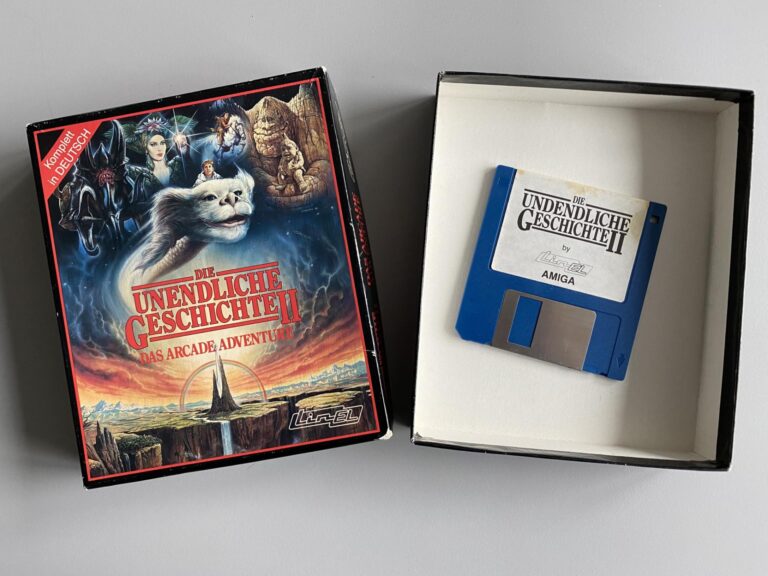
Figure 11: Die Unendliche Geschichte II (1990), German version. Source: Suter
The game publishing business worked much better with Italy. This was also due to the fact that the uncle of the owner of GENIAS was the head of Sofitel. Although Sofitel was not the largest distributor in Italy at the time, the company was able to focus strongly on LINEL’s products, which made it very successful. The same was true for Swiss distributor Logico Software. Grimmer says: “As far as I know, Logico sold over 5000 copies of the game Crack in Switzerland in the year 1988. That was an astronomical number for Switzerland.” (Suter 2023) At the time, there were so many pirated copies of games in circulation that there was a fear that the game would not sell. “But the Chauffats [Logico Software] did an excellent job in the very difficult Swiss market.” (ibid.) Sofitel was equally committed. And so was Systeme 4, a small distributor in Spain based in Madrid. According to Grimmer, they also did a good job, selling a surprisingly large number of copies of La Historia Interminable II (1991), the Spanish version of The Neverending Story II, despite the difficult environment.
Grimmer explains: “Italy and Spain were the ‘cheap countries’ back then. People there didn’t have much money to buy games.” (Suter 2024d) This meant that games had to be sold on cassettes at low prices for a long time. In the 1980s, England was the biggest market for the game industry. “Then it slowly shifted to Germany. There young people had enough money to buy a C64 and a disk drive. They didn’t want to buy a ‘datasette’ and wait 20 to 30 minutes for the game to load. They wanted to put the disk in and play right away.” (ibid.) But in the beginning there weren’t many games on floppy disks. It took off gradually. In England, no one could afford a floppy drive. In Germany, a Commodore 64 computer cost DM 900, and a disk drive cost another DM 750. You could afford that in Switzerland, and maybe in Germany and Austria. Not in England, and certainly not in Italy or Spain. There you could just buy a ‘datasette’ for less than £50, so the market for games took off a little later in Germany. But when the British realized that they could make money there, they suddenly started making floppy disks too. Grimmer: “It was mainly a question of storage space. Sometimes you had to load programs for up to an hour with a ‘datasette’. But when they watched for half an hour just to see the game crash, the frustration was huge.” (ibid.) It was much more convenient to load it from a floppy disk or an 800kb disk.
Wrapping it up
After 1996 there were no more secondary releases of LINEL in disk mags. One or two games like Traders were still included in one or two compilations of Amiga or PC games that came out as retro collections, for example the Gamebox with 50 games for PC from distributor Funsoft/Softgold (1996). As a publisher, LINEL officially continued its business until all contracts had expired and was then dissolved in the year 2000.
“In those years, it wasn’t easy to coordinate with people abroad”, Grimmer says. “I was living in a hotel for six months of the year. Eventually, I got fed up with that. This is fun when you are young. But there comes a time when you don’t want to drive from Switzerland to Munich or Nuremberg overnight to meet with the Gong Verlag and then drive on to Paris the next day and spend the night somewhere along the freeway.” (ibid.)
At the time, games were not sufficiently accepted in society. “People outside the industry laughed at us. The games industry was not taken seriously in general”. (Suter 2024e) This changed later, “but”, Grimmer continues, “with all the ‘funny characters’ that were around, the business world tended to see the games market as something very odd.” (ibid.) Nevertheless, people with a little more insight saw the great potential. But Grimmer’s friends and acquaintances didn’t really get it either. “Some found it strange that I was abroad for six months of the year, while others found it exciting that I ‘could’ travel so much. For me, it was an exciting time that brought me a lot personally, and I met a lot of people I would never have met otherwise.” (ibid.)
Markus Grimmer switched from publishing and developing computer games back to business software in the mid-1990s, working as a consultant for one or two large companies. He specialized in software for accounting and the commercial sector. Today, he lives in Spain and runs an Internet company there. When he left Switzerland a few years ago, he had to clean out his house. Unfortunately, he got rid of all the LINEL materials that were still in his house. However, he still has fond memories of his exciting years with LINEL.
[1] In the booklet of Necronom (1991 ) the name for the disk duplication location is given as Copytec England. According to Markus Grimmer, this was the duplication factory of John Allen in High Wycombe.
[2] The booklet of Necronom (1990) mentions John ‚The Brush‘ as the artist of the concept art used for the box cover. ‘The Brush‘ is the nickname for John Smyth. He also created the cover art for the LINEL game Skate of the Art (1989). John Smyth was born in 1946, in Blackheath, South East London, England. He worked for the studio Words & Pictures which designed gaming packaging for many companies of the era, notably Mastertronic and Melbourne House. He designed the Mastertronic mascot, „Mistertronic“. On mobygames, he is credited for doing artwork for 68 games!
Amiga Museum France. https://amigamuseum.emu-france.info/,
Le monde des jeux Commodore „Unreleased“ https://amigamuseum.emu-france.info/unreleased.htm, (16.08.2023).
Borngiesser, Jürgen (1994). Wüstenei mit Karl May. Vorschau (Preview). In: Aktueller Software Markt. Die Computer-Software-Fachzeitschrift, ASM 6/1994, p.123. Accessible via kultboy.com: https://www.kultboy.com/index.php?site=t&id=1499, (15.08.2023).
Bronstein, Lenny (2020). Maze Patrol. Linel 1987. In: Games that weren’t: 64. 2020. https://www.gamesthatwerent.com/gtw64/maze-patrol/, (28.09.2023).
c64 werner (2010), Eureka – Commodore 64, In: Youtube, https://www.youtube.com/watch?v=6KMqP7VAN7U&t=205s, (23.04.2024).
Eureka! Software Review (1984). In: Computer and Video Games (CVG) 12/1984, p.46.
Cork, Ste(ven) (1999). Trivia Quote. In: Mobygames, The Neverending Story II: The Arcade Game, MobyGames ID: 528, https://www.mobygames.com/game/528/the-neverending-story-ii-the-arcade-game/, (10.12.2023).
Duy, Manfred (1993). Der Schatz im Silbersee. Vorschau (Preview). In: Amiga Joker, 11/93, p. 15. Accessible via kultboy.com: https://www.kultboy.com/index.php?site=t&id=13263, (15.08.2023).
Duy, Manfred (1994). Der Schatz im Silbersee. Viel Juhu um Winnetou. Vorschau (Preview). In: Amiga Joker, 3/94, p. 32-33. Accessible via kultboy.com: https://www.kultboy.com/index.php?site=t&id=358, (15.08.23).
Genzel, Christian (2014). Interview: Roland Meyer über seine C64-Listinggames. In: Wilsons Dachboden, Lichtspielplatz, Interviews, Ghost Light Productions, München, 9. Dezember 2014, https://www.wilsonsdachboden.com/2015/01/interview-ronald-mayer-uber-seine-c64.html, (28.09.2023).
Grimmer, Markus (1993). Karl May’s Der Schatz im Silbersee. Booklet with introduction and manual for the PC game. LINEL, Software 2000: Eutin 1993.
Haller, Christian (2014-2024), Christian Haller’s Amiga World. https://insanityfight.com/index.php, (15.02.2023).
Ippisch, Hans. Der Schatz im Silbersee. Vorschau (Preview). In: Amiga Games 8/93, p. 74-75. Accessible via kultboy.com: https://www.kultboy.com/index.php?site=t&id=10364&s=1 and https://www.kultboy.com/index.php?site=t&id=10364&s=2, (15.08.23).
Kleimann, Manfred. LINEL – ein schweizer Team mit Perspektiven! In: Aktueller Software Markt. Die Computer-Software-Fachzeitschrift, ASM 2/1988, p.24-25.
Krummenacher, Dave and Larissa Wild (2023). Interview with Christian Haller, 07.09.2023, Transcription (German), CH-Ludens Archive. (unpublished)
LemonAmiga (2004-2024), platform for classic Amiga games. List for publisher LINEL. https://www.lemonamiga.com/games/list.php?list_publisher=Linel , (15.08.2023).
LemonC64 (1998-2024), platform for classic C64 games. List for publisher LINEL. https://www.lemon64.com/games/list.php?list_title_option=contains&list_title=&list_company=linel , (26.12.2023)
LemonC64 (2005), platform for classic C64 games. Comment by by Belshazzar with date 2005-06-11. https://www.lemon64.com/game/catalypse, (26.12.2023).
Lott, Gunnar und Christian Schmidt (2019). Stay Forever, SFS 13, Drachen von Laas #7 „Interview mit Guido Henkel“, Podcast, 07.06.2019, https://steadyhq.com/de/stayforever/posts/9316717f-2b11-43bf-accf-8428f12c9275 (14:51 – 24.50).
Löwenstein, Richard (1992). Aquatic Games & Reach out for Gold. Das Olympische Comic-Doppel. Vorschau (Preview). In: Amiga Joker November 1992, pp. 16-17. Accessible via AMIGA Magazine Rack: https://amr.abime.net/review_25840, (17.11.2023).
Mobygames (1999-2024), platform for documenting and preserving video game history. List of LINEL games. https://www.mobygames.com/company/1482/linel/, (15.08.2023).
Nettelbeck, Joachim and Michael Labiner (1991). Die unendliche Geschichte II. Hotspot: Demnächst auf diesem Computer (Preview). In: PC Joker 6/91, p.8, Accessible via kultboy.com: https://www.kultboy.com/index.php?site=t&id=17082, (16.08.2023).
News from LINEL (1988). In: Génération 4, No.6, November 1988, p.111. Accessible via Oldies but Goodies. Le site des jeux Vidéo rétro. https://www.oldies-but-goodies.fr/index.php?page=magazine&id=259&filter=2, (15.08.2023).
Pfister, Eugen (2024). E-Mail Exchange with Michael Tschögl (German). 14.01.2024 (unpublished).
Steinwachs, Matthias (1995). Musik zur Wüste. In: The Thalion Source. Text aus PC Games 4/95. Düsseldorf 1995, http://thethalionsource.w4f.eu/Artikel/Steinwachs_Wueste.htm, (30.09.2023).
Suter, Beat (2023). Conversation with Markus Grimmer. Via Zoom (Swiss German). 28.11.2023, CH-Ludens Archive. (unpublished).
Suter, Beat (2024a). E-Mail Exchange with Markus Grimmer. 16.01.2024, CH-Ludens Archive. (unpublished).
Suter, Beat (2024b). E-Mail Exchange with Markus Grimmer. 22.01.2024, CH-Ludens Archive. (unpublished).
Suter, Beat (2024c). E-Mail Exchange with Markus Grimmer. 23.01.2024, CH-Ludens Archive. (unpublished).
Suter, Beat (2024d). Conversation with Markus Grimmer. Via Zoom (Swiss German). 04.03.2024, CH-Ludens Archive. (unpublished).
Suter, Beat (2024e). E-Mail Exchange with Markus Grimmer. 21.03.2024, CH-Ludens Archive. (unpublished).
Suter, Beat (2024f). E-Mail Exchange with Markus Grimmer. 22.03.2024, CH-Ludens Archive. (unpublished).
Interessanter Artikel zur Repräsentation von Fraune in Video Games. Leider klammert der Artikel die leidigen Pornogames des Atari 2600 aus. Aber das lässt sich ja auch mal offiziell nacholen .-(
[Dieser Text ist nicht umfassend, sondern soll lediglich ein erster Approach sein zum Thema der Relation Sprache und Computerbedienung/Programmierung. Selbstverständlich hat es daneben noch viele andere Entwicklungen gegeben. Aber das ist Stoff für einen anderen BlogEintrag. ]
Schaut man sich die ersten grösseren Computersysteme im Mainframebereich wie etwa Plato Systems (ein Multiuser Elearning System) von Ende der 60er Jahre an, so wird einem sehr schnell klar: hier steht ein sprachliches Paradigma im Hinter- bzw. im Vordergrund. Input (Keyboard) wie auch Output (Vorallem Text). Wobei allerdings gesagt werden muss, dass PLATO Systems Texte auch mit Grafik mischen konnte (also nicht nur ein Textterminal besass).

Die Idee ist, dass der Mensch seine natürliche Sprache nutz als Schnittstelle zur Bedienung (und zur Programmierung) des Computers alias Universalmaschine alias simulierter Mathematiker mit Stift. Der Output ist dabei auch mehrheitlich Schrift. Dies scheint das Ende der langen Standardisierung von Sprache zu sein. Man programmiert keine Menschen mehr über Schulen und Bücher (GutenbergGalaxis), sondern nun eben die Turing Maschine und die dann den Menschen.
“To ensure that all algorithms are translated in a uniform language, Turing defines a machine that consists of only a few essential language elements. The machine reads characters from an input device and writes characters to one output medium – and only a finite number, since the algorithm is finite.”
Betz, André: Das eindimensionale Universum: Eine Einführung in ein informationstheoretisches Weltbild. Berlin 2003. S 10
Was liegt also näher, wenn das Gegenüber ein Rechenknecht (andere würden sagen: ein Sklave) ist. Das lässt sich natürlich technisch nicht 1:1 lösen (bis heute zu viel Ambiguitäten), deswegen ist das real genutzte Paradigma dann auch der Imperativ oder einfacher der ‚Befehl‘. Hier werden wenigstens einige Ambiguitäten der Sprache (ihr Vor- und immer auch Nachteil) ‚disambiguiert‘.
„Alan Turing entwickelte über die Entscheidungsprobleme einen genauen Begriff des Algorithmus. Ein Algorithmus ist im Prinzip nichts anderes als ein Kochrezept, das dem Koch in endlichen, eindeutigen, in jeder Küche ausführbaren und allgemein verständlichen Schritten erklärt, wie etwas gekocht wird. Auf einem Computer entspräche dies einem Programm.“
Betz, André: Das eindimensionale Universum: Eine Einführung in ein informationstheoretisches Weltbild. Berlin 2003. S 10
Bei Plato Systems (Programmed Logic for Automatic Teaching Operations, 1968+) wartet auch folgerichtig ein „>“ auf die Eingabe eines Befehls in diesem Fall eine Lektion (Plato ist ein Elearning System). Der Computer steht also Gewehr bei Fuss um Befehle anzunehmen, um beim Martialischen zu bleiben (Plato wird anfangs vom US-Militär finanziert).
Das sprachliche Paradigma findet sich anschliessend weiter bis hin in die Programmiersprache Tutor des Systems. Hier gibt man mehrheitlich Befehle ein, die man aneinander reihen kann durch Umbrüche getrennt (keine Zeilenorientierung aber fixed Format). Jede Zeile ein Befehl (Python-Programmierer* haben ein DejaVu). Die Programmiersprache Tutor ist dabei klar an natürliche Sprache angelehnt. Tutor-Code liest sich wie eine Art Text mit Leerstellen (Isers Leerstellentheorie 1972 könnte fast als Template gedient haben oder umgekehrt). Die Eingaben können gefiltert werden, Alternative Lösungswörter (Box oder Cube etwa) oder falsche Lösungswörter können angegeben werden (Answer judging) in einem Input und Füllwörter werden automatisch ausgefiltert. Folgendes Beispiel zeigt die Mächtigkeit dieses Ansatzes
answer <it, is,a, it's, figure,
polygon>
(right, rt) (triangle, triangular)
Das ganze System fühlt sich sehr sprachlich an, weit sprachlicher als vieles was danach kam. Es ermöglicht auf einfachster Ebene Sprache und Eingabe zu parsen.
Weiterlesen